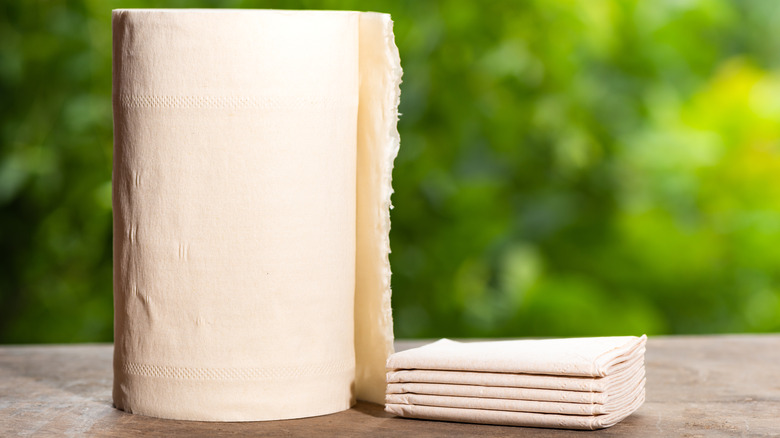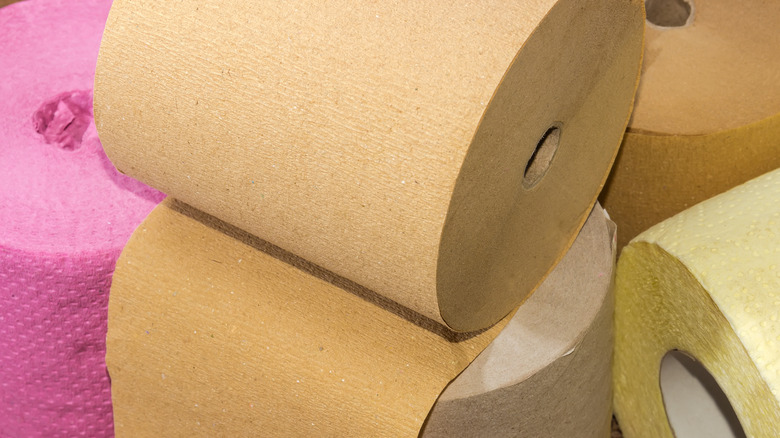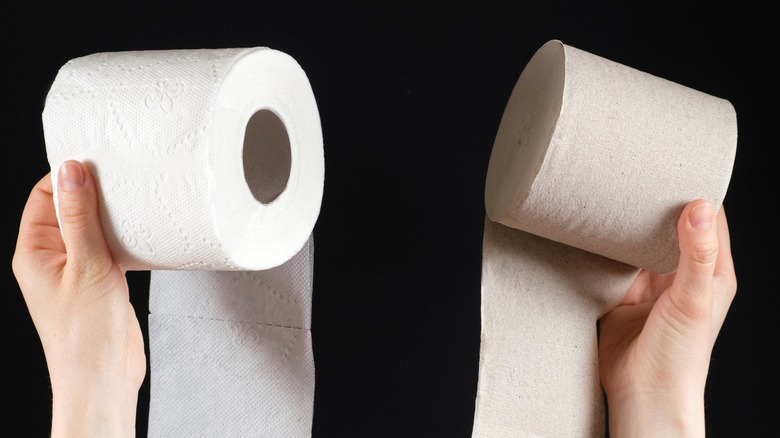What Makes Unbleached Toilet Paper Different (And Should You Buy A Pack?)
According to a consumer market report, Americans use an average of 141 rolls of toilet paper per person per year. Often, the concern around toilet paper consumption is the impact its disposal has on the environment, but have you ever wondered how toilet paper is manufactured and what impact that process might have? Similar to the paper that we write and print on, toilet paper is made from trees. The steps are actually quite complex and include stripping a tree of its bark, deconstructing the tree's wood into chips, and then cooking the chips to create pulp, which is then cleaned and pressed. However, if the toilet paper is made from recycled materials, the process begins with ingredients sans freshly harvested trees.
And all toilet paper is not created equal. From the less expensive 1-ply variety found in most public restrooms to the more expensive lush 3-ply you spring for when you have guests visiting for the weekend, the type and quality varies. In thinking about toilet paper, you may have also wondered what the difference is between unbleached and bleached toilet paper. It's a question worth asking, especially if you're environmentally conscious or concerned about potential health risks associated with bleaching agents. There are several reasons why a consumer may opt for unbleached toilet paper: Its impact on the environment could be less damaging, and the paper's surface is less irritating (if you have sensitive skin). While choosing between bleached or unbleached toilet paper ultimately comes down to personal preference, here are a few insights that might help decide which product is best for your household.
Unbleached toilet paper and the environment
Odds are, if you've washed your hands in a public bathroom, you've encountered unbleached paper products. Yes, those brown, highly nonabsorbent disposable paper towels that never seem to get your hands dry enough. While the term unbleached may give the warm-fuzzies that unbleached products are chemical-free, this is actually not the case. Both bleached and unbleached paper require the use of chemicals during the manufacturing process. These chemicals are necessary to remove fiber from the wood source so the fiber can then be processed into paper (at least, paper as we know it).
Though processing unbleached toilet paper still requires minimal chemicals during its processing, those chemicals have been reported to be less environmentally harmful. Hydrogen peroxide is one of those alternatives used in making unbleached toilet paper via the totally chlorine-free (TCF) process. Interestingly enough, paper manufacturers haven't fully bought into this alternative bleaching process because TCF has yet to prove its superiority to other paper-producing methods in terms of environmental impact. Unbleached toilet paper products, like bamboo toilet paper, also get a bad rap because of the harshness and thickness of the paper.
The pros and cons: Unbleached versus bleached toilet paper
Historically, bleached toilet paper required the use of additional chemicals, such as chlorine. Unfortunately, during the bleaching process, these chemicals could be released into the environment, contributing to water pollution. Another hesitation toward the bleaching of paper products is that bleach not only harms the environment but also causes skin irritation and even triggers allergies for some individuals. This is of particular interest to those with sensitive skin types. However, in recent years, the U.S. pulp and paper industry switched to an Elemental Chlorine Free (ECF) process. This process uses a chlorine derivative called chlorine dioxide, which has fewer negative impacts than actual chlorine.
This insight may leave you wondering why people even buy unbleached toilet paper at all — especially since bleached toilet paper has had the market cornered in terms of softness and durability. Not to mention that bleached toilet paper is more readily available and affordable — unbleached toilet paper, not so much. Not to fear, if you're feeling compelled to make the switch to unbleached toilet paper, its availability is increasing as the demand for more eco-friendly products is increasing.


